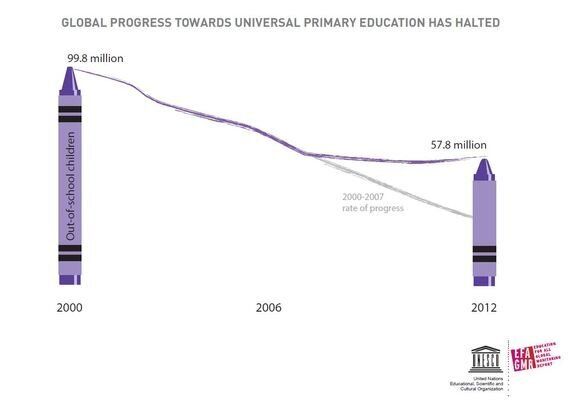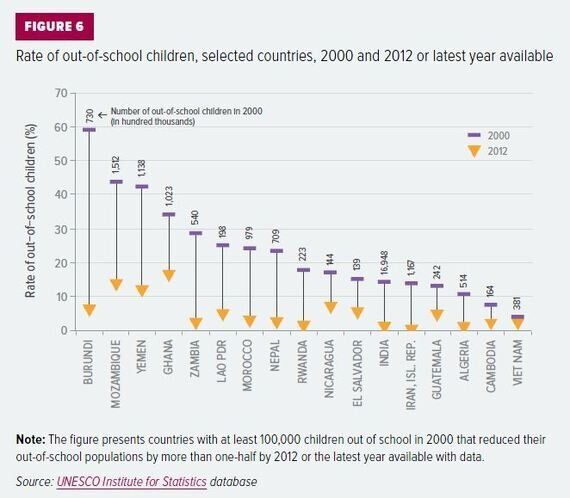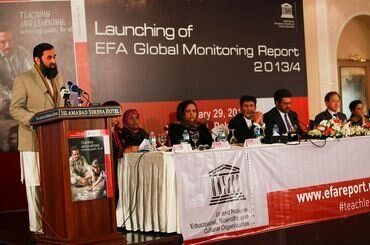Pakistan has a heavy task ahead of it: new UNESCO figures show that almost five and a half million children are still out of school in the country - more than in 2010, and among the highest levels in the world.
The news that the high number of out of school children in Pakistan has stagnated since 2009 comes from a newly released paper by UNESCO and the EFA Global Monitoring Report (EFA GMR). It follows news from the EFA GMR showing that Pakistan also suffered the second largest cuts in aid to education of any country in the world in the last two recorded years. Pulling these two stories together, it is starkly evident that some donors are pulling their aid to education just when it is most needed.
Sadly, this trend of stagnating out of school children and declining aid is not reserved for Pakistan. Global figures show a similar association: 58 million children are out of school globally, with barely any improvement since 2007. At the same time, the amount of aid to education has been cut by a tenth in the last two recorded years. It is worrying in the extreme to see both international aid and out of school numbers moving in the wrong direction.

Today's new paper holds several key nuggets of advice, which Pakistan may find useful as it works on its National Plan of Action to help achieve education related goals. Having monitored education progress in every country around the world since 2000, the EFA GMR has garnered considerable knowledge about which countries are managing to buck the global trend and achieve faster progress in education, and how. Why is it that Nepal has succeeded in reducing the percentage of children out of school from 24% to just 1% in just over a decade? How has Vietnam halved its out of school rate since 2002?

Seven policies clearly stand out as substantially reducing out of school numbers and in very different contexts. These include abolishing school fees, increasing spending on education, improving education quality, introducing social cash transfers to offset the costs of schooling, introducing teaching in local languages and overcoming conflict.
For Pakistan, where school fees have been abolished since 2010, and the Right to Education Act is now enacted in most of the provinces, the government's attention should turn to accelerate the impact of these reforms by considering policies reaping rewards in other countries. Doubling spending on education in Ghana, for instance, helped halve its out of school rate. Pakistan, meanwhile, is one of only three countries outside of sub-Saharan Africa to spend less than US$150 per primary pupil on education. Its recent commitment to increase spending from 2% to 4% of GDP by 2018 could go a long way to creating a better balance of access and quality if delivered. Steps must be taken now to ensure this promise is kept. After all, while aid is a vital resource for countries looking to expand their education systems, the overall responsibility lies on governments' shoulders.
Improving quality in Pakistan would also be a huge breakthrough. In rural areas many primary schools lack sufficient classrooms to provide a proper five year cycle: In Khyber Pakhtunkhwa, for example, more than half of the schools do not contain the requisite 5 classrooms (one per grade). If you were a parent, would you send your children to school, and keep them there, if school conditions meant that your children were unlikely to learn the basics?
Our latest EFA GMR showed that fewer than half of children are learning the basics in Pakistan whether they've been to school or not. There is also a huge need for more qualified teachers - especially female teachers - to help encourage more girls to remain in school. Afghanistan, for example, aims to increase the number of female teachers by 50% by this year, so as to close the learning gap between girls and boys. In Pakistan, however, at current trends the recruitment gap will not be filled until after 2030. Until these challenges are addressed head-on, its out-of-school rates will likely languish.
Similarly, conflict in Pakistan has taken its toll on education access. One only needs to recall the attacks experienced by Malala and other children to understand how ongoing security threats are leaving many children scared to go to school. Ending civil war in Nepal helped children living in affected areas begin to have the same education chances as children living in other parts of the country. A similar shift to security in Pakistan would no doubt see similar advantages for its boys and girls, who have long awaited the stability.
Lastly, large scale social cash transfers should be strongly considered for their ability to help bridge the divide between the percentage of the richest and the poorest children accessing school. Our World Inequality Database on Education shows the richest children in the country are more than seven times as likely as the poorest to go to school. We are heartened by the news that the Sindh province is switching to branchless banking cash transfers for girls' education in poorer households and hope this will show just how effective they can be in overcoming poverty barriers to education. Distributing government funds via cash transfers through Parent Teacher Councils, as in Khyber Pakhtunkhwa, is a transparent scheme that can also avoid funds being filtered off before they arrive at their intended destination.
Transfers such as these will not address the equally important challenge of enabling children to remain in school once there, however, and are insufficient as a standalone intervention for increasing access. Nevertheless they are extremely important for helping the marginalized set foot in the classroom--in some cases, for the first time in their lives--and should be scaled up for all families in need throughout the country. For these very reasons it is noteworthy that these schemes are among the first interventions, which the Malala Fund has helped put in place.
With 2015 just around the corner, the international community will be setting for itself new global education targets. An essential part of that process is identifying lessons about pockets of progress since 2000, in countries like Burundi, Vietnam, and Nepal, in order to help other countries build on and benefit from the same advances.
Faced with the news that out of school numbers in Pakistan are still shockingly high, the government should make every effort to use this evidence to take stock and realign its priorities. Donors, similarly, must recognize that tangible change can come from backing effective policies and providing not just the aid, but also the expertise to put them in place.

It was welcome news to hear H.E. Mr Muhammad Baligh-ur-Rehman, the Federal Minister of State for Education, Training and Standards in Higher Education announce at the launch event for our latest Report in Islamabad this January that he would be implementing a National Plan of Action for Education to accelerate progress and doubling education spending. With this political will, and increased funds to turn that will into action, we hope Pakistan will reflect on those policies identified as having success in other countries and strongly consider how it can draw insights from such successes on its own terrain.
